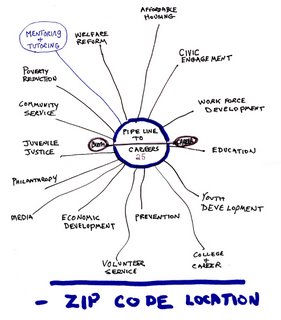
At the left is a drawing I made today to illustrate a concept that I've been trying to articulate for a long time. (just double click the image to enlarge it)
The hub of this drawing represents a single youth. Or, it could represent all of the young people in a zip code, or a community.
If the community has high concentrations of poverty, it's likely that the young people are not finishing school, or if they do finish school, they are not as well prepared for jobs, college and careers as are kids who did not live in poverty.
Brian Scales, from Mentors, Inc, based in Washington, DC, sent me an article today titled, Saving Futures, Saving Dollars. You can read it at this link (this is updated 2012 version)
This article illustrates the huge benefit to society if we'd just find more ways to help kids born in poverty be starting jobs and careers by age 25. We're reminded of this problem at least once a day in our local newspapers, either with a story about teens killing teens, or high school test scores. Yet, nothing seems to change.
Maybe one of the problems is that we're all divided into sub groups, based on how we see the problem, who we are, and where we are. My concept map illustrates this. I've heard many people use the term "pipeline to careers", but not many map a strategy that identifies all of the different resources that are available to kids not living in poverty, which need to be made available on an age appropriate, continuous basis, to more of the kids who do live in poverty.
My concept map illustrates that there are many groups of people/organizations who are working to end poverty. However, they are not connected to each other, the way sub contractors are connected to each other in the blueprints that are used to build a house, or a tall building.
Because of the way philanthropy and public attention work, we spend billions to fund lots of different actions, but don't achieve the results we want because the funding does not go to all of the different groups in a zip code who need to be in that zip code, nor stay there on an on-going basis until the neighborhood reaches a "tipping point" in which a majority of kids are headed to school with positive aspirations, the motivation to learn, and a network of adults available, and willing to help them.
The reason I'm so positive about volunteer-based tutoring/mentoring is that out of all of the ideas represented on my map, this is the only one that has the potential of getting large numbers of people who don't live in poverty, personally involved in the lives of young people who do live in poverty.
I know from my own experiences that the longer a person stays involved, the more he/she will understand what the issues are, and the more they will be willing to devote a greater amount of time, talent, dollars and personal involvement to helping a child who is not their own have the same opportunities for college and a career as if they gave birth to that child.
School is starting and all over the country tutor/mentor programs are looking for volunteers. They are looking for donors and leaders, too. I hope that anyone who reads this will get involved, and encourage others to get involved.
However, I also hope that people who are working with social networking, collaboration, e-learning and other concepts that might help people get informed, then involved, will work with me to create a process of convergence that links leaders, volunteers and donors who are represented in the different sub groups on my map, with each other, in a process that leads to more comprehensive, and longer-lasting strategies for helping youth move up the pipeline from poverty to careers.
If you're interested in learning more, or helping me create computerized concept maps, visit the Tutor/Mentor Institute section of http://www.tutormentorexchange.net to view additional essays that show how maps can help create understanding and shared commitment to building more and better volunteer-based tutor/mentor programs where they are needed.
Dan Bassill
Tutor/Mentor Connection
Cabrini Connections








2 comments:
A worthy and auspicious undertaking! I love the idea of using social networking to promote volunteering. Perhaps social networking can even BE volunteering. Here's an interesting article on Myspace doing just that thing. Lots of other great resources there, too.
http://www.worldvolunteerweb.org/take-action/get-involved/doc/social-networking-site-launches-contest.html
I certainly agree. Some forms of volunteer involvement bring together more diverse networks of people, and are more likely to encourage interaction and networking among volunteers.
Some non profits may be more effective at encouraging such networking. This has always been a core strategy of the Tutor/Mentor pograms that I've led, and it's one reason that so many volunteers have taken leadership roles and have stayed involved longer.
If we can connect volunteers from different places who do similar types of volunteer work, using the internet as a meeting place, we can create larger networks with greater impact on the cause.
Post a Comment